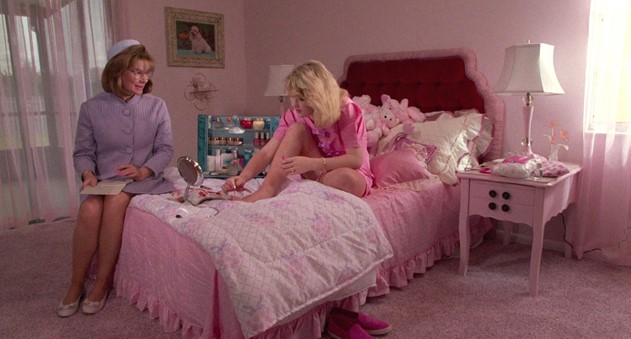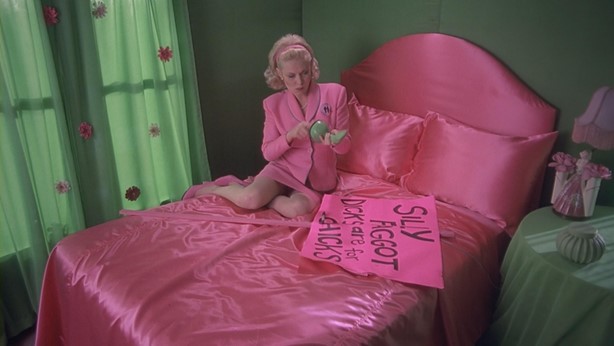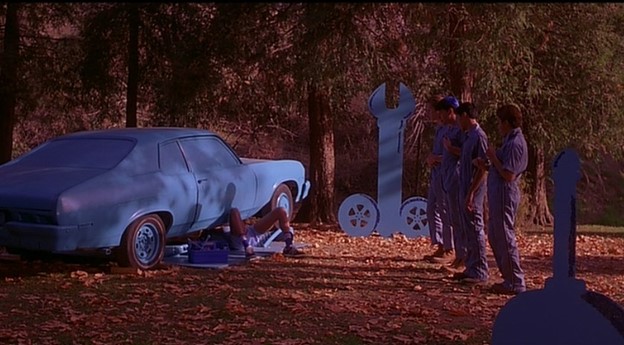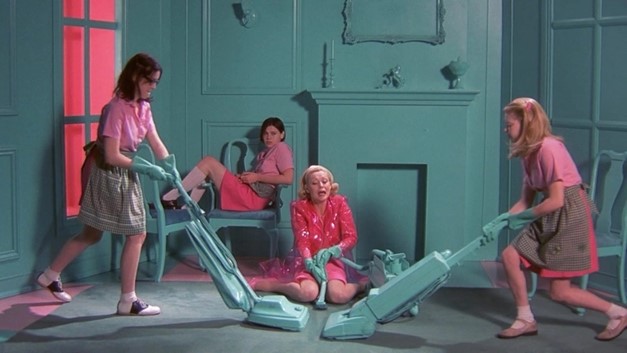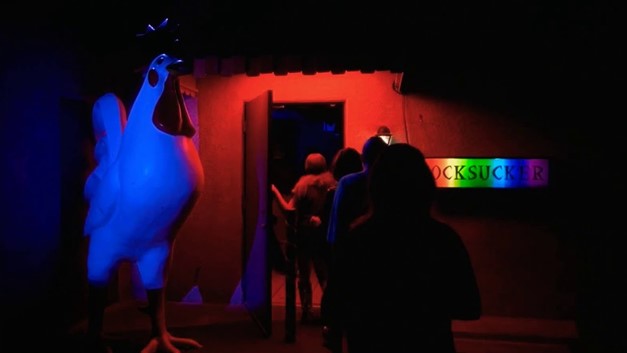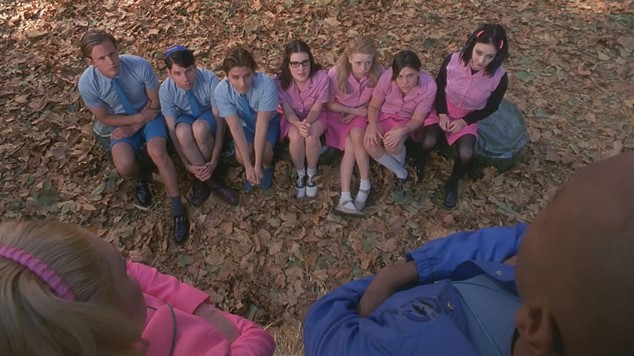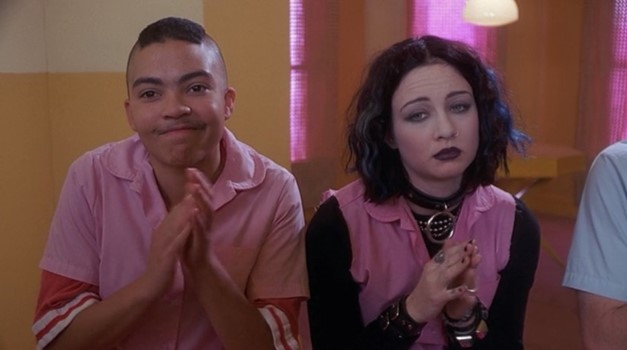But I’m a Cheerleader (1999) is a satirical rom-com directed by Jamie Babbit and starring Natasha Lyonne as the film’s protagonist Megan, a closeted cheerleader. Megan is sent to a conversion therapy camp by her friends, family, and boyfriend after they suspect her of being a lesbian due to feminine and vulva-esque motifs in her decorations — all of the posters in her room and locker are of women — and the fact that she does not enjoy kissing her boyfriend. After her family, friends, and boyfriend suspect her of being a homosexual, Megan is sent to a conversion therapy camp run by Mary Brown (Cathy Moriarty), who is in charge of the girls at the camp, and Mike (RuPaul), who is in charge of the boys. Megan and the other youth at the camp have to perform and pass a series of exercises and tests throughout the film in order to “correct” their sexual desires, including cooking, cleaning, and dressing feminine for the girls, and yard work and learning how to fix cars for the boys. At first, Megan is open to changing herself and her sexuality through the program, but as she gains more confidence in her sexuality and falls for one of her peers, Graham (Clea DuVall), she rejects the camp and strives for the freedom to be herself.
Production design often gets overlooked in film recognition and academic research, with even EasyBib not including “production designer” as a drop-down title for credit in their film citation generator; titles included are director, producer, writer, screenwriter, adapter, and performer (Staff, EasyBib). However, the mise-en-scene of But I’m a Cheerleader is extremely important and crucial for the LGBT+ themes of the film, with its homoerotic props, gendered color schemes of rooms and clothing, and hair and makeup differences between the characters. In this mise-en-scene scrapbook, I have gathered stills and images from But I’m a Cheerleader and other works that inspired the film’s aesthetics, sets, and costuming, and placed these in context with the LGBT+ representation and themes in the film.
Setting, Décor, and Properties
Most of But I’m a Cheerleader takes place at the conversion therapy camp called “True Directions.” The house is very feminine and grandiose, with each room being meticulously themed and decorated. The girls and the boys sleep in gendered dormitories, with the girls’ entire room being pink; including the walls, floor, and bedding. Many of the sets in the house and on the screen feature one prominent color, usually either pink or blue, and sometimes a hint of green as an accent color. The production design of the film has a very generated and created sense to it, which reflects on the false binary world that the conversion camp is trying to adhere to. In an interview with Cynthia Fuchs for NitrateOnline.com, Jamie Babbit talks about her inspiration for the film’s aesthetics and mise-en-scene, citing Edward Scissorhands (1990) and the whole Barbie franchise as huge inspirations for the film (Fuchs and Babbit). As shown in Figures 1 and 2, the similarities between the set design and color scheme of Edward Scissorhands and But I’m a Cheerleader are quite similar, even the lighting design and angle of the camera are similar.
The inspiration from Edward Scissorhands is very apparent in the film’s production design, with many of the sets reminiscent of the colorful, cheerful, and artificial suburban lifestyles shown in Edward Scissorhands. Jamie Babbit wanted the production design of her film to feel fake and manufactured, reflecting on the constructed gendered world that the conversion camp is trying to maintain and reinforce in the youth. In her article titled, “But I’m a Cheerleader: Queer in Content and Production,” Syd Martin analyzes the artificiality of the sets, stating that, “Throughout the film, as the characters try harder and harder to adhere to the roles they are given, the production design becomes more and more artificial-looking until, at their graduation ceremony, even their clothes are made of plastic” (3). Martin then goes on to talk about the phallic and homoerotic symbolism in the film’s set and prop design, and how this alludes to the idea in the film that your sexuality cannot be changed or “corrected,” and that repressing your identity will lead it to come out in other ways.
Overall, the set design in But I’m a Cheerleader creates an overly saturated and absurd reality that reflects on the artificiality of the conversion camp that is trying to turn the youth into people they are not. Most of the sets are either blue or pink, with blue being the prominent color for the boys and pink being the prominent color for the girls. The use of pink and blue in the set design reflects on the overcompensation of the character’s “ex-gayness” in trying to prove that they are heterosexual manly men or heterosexual feminine women. The production design of the film does a great job at illustrating the artificiality of the “True Directions” program, and the lighting works in sync to further this idealist illusion.
Lighting
Jamie Babbit cites Edward Scissorhands as a huge inspiration for her debut film, But I’m a Cheerleader; this not only shows up in the production and set design of the film, but also in the lighting. Most of the film is shot with soft, high-key lighting, a technique commonly used in classic Hollywood films. High-key lighting creates a lit frame that limits the harsh shadows in the image, making the image and the actors look softer. This lighting technique is used in more upbeat films or television series and makes the actors appear more flattering and the scenery more lively. However, as Jo Light describes in their 2020 article, “Need Upbeat, Comedic-Style Lighting? Try High-Key” the use of high-key lighting can be used meticulously to juxtapose an artificial reality, stating, “This makes the characters look happy and honest, but could also signal to the viewer that their world is not exactly reality.”
The perfect, shadowless world that But I’m a Cheerleader presents on-screen calls out to the viewer that it is created, reflecting on the themes dealing with gender construction and trying to conform to gender roles in order to affirm heterosexuality and heteronormativity. Although the majority of the film uses high-key soft lighting, there are a few scenes with low-key lighting and shadows, most notably, the gay club scene. During this scene, the youth at the conversion camp sneak out to go to a gay club where they are fully able to be out and be themselves. This scene breaks away from the artificial world presented for the majority of the film; the youth are able to openly express their sexuality, and this is reflected in the drastic change in lighting.
Costume, Makeup, and Hairstyles
The costuming, makeup, and hairstyles are also extremely important factors in the mise-en-scene of But I’m a Cheerleader and the film’s LGBT+ context. As stated before, the conversion camp in the film divides the youth at the camp by sex assignment, with the girls living together in an all-pink bedroom and although the boys’ bedroom is not featured on film, it can be inferred that their bedroom is decked out in blue. Just like the set design breaks the youth up by sex assignment with blue and pink, the costuming does the same. The girls at the camp are forced to wear the same pink uniform and the boys are forced only to wear the same blue uniform (with some characters using their agency to tweak the uniform to their individuality). This heavy use of pink and blue, and the distinction that pink is for girls and blue is for boys, reinforces the themes that the film is satirizing.
The makeup and hairstyles of the characters are also used to poke fun at the gender roles and stereotypes in society. For example, many of the lesbian characters sport short, dyed, or messy hair, and either wear “too much” makeup or none at all. Mary Brown, the “True Directions” therapy camp head in charge of the girls, serves as the embodiment of heterosexuality femininity that the girls are supposed to achieve; has simple, yet feminine makeup (pink blush and lips); and wears her hair down and styled out. The film calls out the association of makeup, dress, and hair with sexuality and gender, when one of the girls at the camp, Jan (Katrine Phillips), states, “I mean everybody thinks I’m this big D*ke because I wear baggy pants, I play softball, and I’m not as pretty as other girls, but that doesn’t make me gay.” This scene directly calls out the stereotype that society places on gender and sexuality, and its association of feminine activities or appearances with women, and masculine activities or appearances with men. Because Jan wears baggy, masculine clothes, has a short haircut, and is not as feminine presenting as most other girls, she is assumed to be lesbian.
Overall, the mise-en-scene of But I’m a Cheerleader is meticulously curated to call attention to the construction of gender and its direct association with sexuality. Through set design, costuming, lighting, and color, But I’m a Cheerleader is able to create a world of artificiality that represents the LGBT+ themes of the film and makes a satire of the heteronormative, gendered binary.
Author Biography
Tessa Throneburg is a junior at the University of North Carolina Wilmington, with a major in film studies and a minor in anthropology. When she graduates, Tessa plans on pursuing a career in production, set, and costume design.
References
Babbit, Jamie, director. But I’m a Cheerleader. Ignite Entertainment, 1999.
Burton, Tim, director. Edward Scissorhands. Twentieth Century Fox, 1990.
Fuchs, Cynthia, and Jamie Babbit. “So Many Battles to Fight Interview with Jamie Babbit.” Nitrate Online, 21 July 2000.
Light, Jo. “Need Upbeat, Comedic-Style Lighting? Try High-Key.” No Film School, 11 Feb. 2020.
Martin, Syd. “But I’m a Cheerleader: Queer in Content and Production.” Cinesthesia, vol. 8, no. 1, 24 Apr. 2018, pp. 1-8, scholarworks.gvsu.edu/cgi/viewcontent.cgi?article=1141&context=cine. Accessed 28 Apr. 2021.
Staff, EasyBib. “Citation Form | MLA | Film/Online Video.” EasyBib, Chegg, 1 Jan. 2021, www.easybib.com/mla-format/film-citation/custom.
TheReclamationProject. “Barbie University Virginia Cheerleader Doll.” Amazon, www.amazon.com/Barbie-University-Virginia-Cheerleader-Doll/dp/B000CQ3AOA. Accessed 28 Apr. 2021.

